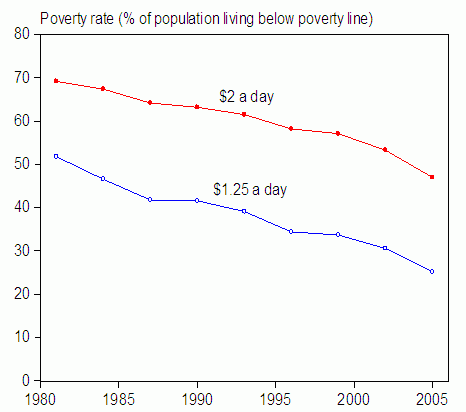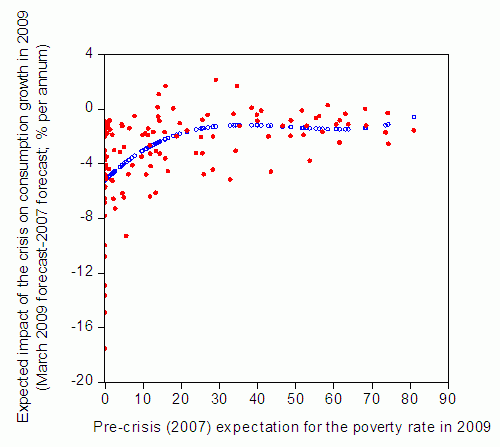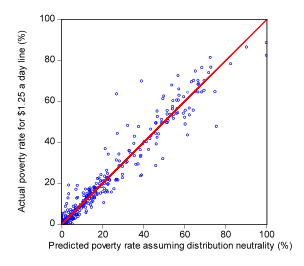Prior to the crisis, the incidence of poverty in the developing world had been on a trend decline. Figure 1 shows our estimates of the poverty rate for the developing world as a whole over 1981-2005 using two poverty lines, $1.25 and $2.00 a day, at 2005 purchasing power parity (PPP) for consumption; the former line is the average of the national poverty lines found in the poorest 15 countries and the latter line is the average for the developing world as a whole. The trend rate of decline in the $1.25 a day poverty rate over 1981-2005 was 1% point per year, and only slightly lower (about 0.8% points per year) for the $2 a day line.
Figure 1. Headcount indices for the developing world, 1981-2005
Note: Poverty lines in 2005 prices. Source: Chen and Ravallion (2008).
This trend would have almost certainly continued in the absence of the crisis, given the expected growth rates prior to the crisis (World Bank, 2008). To assess what impact the crisis is likely to have on aggregate poverty we need to estimate the difference between the expected level of poverty, given the crisis, and what we would have expected based on the pre-crisis trajectories. This article provides our estimates of that impact for 2009 and 2010.
Growth impacts of the crisis
The poverty impact of the crisis in a given country will depend on how it affects both average consumption and the distribution of consumption relative to the mean. The World Bank has made projections for average consumption at country level, which can be compared to the Bank’s pre-crisis projections to assess the expected impact of the crisis. We use the World Bank’s latest growth projections for 2009 and 2010 (as of mid-April 2009) as the “post-crisis” growth rates while the counterfactual (pre-crisis) projections for those done by the Bank in December 2007 for 2009 and 2010.. We have used the growth projections for private consumption per capita. Consumption is more appropriate than GDP for predicting the short-term impacts on poverty, since the shock to GDP is unlikely to be passed on fully to consumption in the short term.
The crisis is expected to sharply reduce growth in 2009. In December 2007, the Bank forecast a growth rate of consumption per capita of 5.1% for 2009. (This is an expenditure-weighted mean for the same set of countries for which we measure poverty using household surveys.) At the time of writing (mid-April 2009), the expected growth rate in consumption per capita for 2009 is 0.7%. The expected growth is lower in 2010, with a pre-crisis rate (as projected in December 2007) of 4.4% versus 2.6% post-crisis.
Figure 2 plots the impacts on growth rates in 2009 across countries against the pre-crisis poverty rate using the $1.25 line. It can be seen that growth impacts tend to be higher in less poor countries. (Eastern Europe and Central Asia figure prominently in this group.) This pattern will undoubtedly help dampen the overall impact on poverty of the crisis.
Figure 2. The expected growth impacts of the crisis tend to be smaller in poorer countries
Note: The fitted values are based on a cubic polynomial. Source: Authors’ calculations.
Distributional impacts within countries
Past experience suggests that relative inequality falls about as often as it rises during aggregate economic contractions, with zero change on average. This is in keeping with one of the stylised facts to emerge from research on growth and distributional change, namely that economic growth tends to be distribution neutral on average (Ferreira and Ravallion, 2009). So the most defensible assumption for the present purpose is that the burden of the crisis will be more-or-less proportional to initial income leaving relative inequality unchanged within a given country.
To test this assumption we have estimated the poverty rates across countries at each available survey using the most recent prior survey and assuming distribution neutrality over the intervening period. In other words, we compare the “actual” poverty rate calculated for a given country at a given survey date t, with a prediction based on the most recent available survey, for date
, say; the prediction is obtained using the mean for date
t but the distribution of incomes normalised by the mean for date
.
Figure 3 gives the results of this test. (The figure uses all the available surveys, with multiple observations for some countries.) It can be seen that the predictions accord fairly closely with the actual values on average at each level of poverty. (There is a sign of underestimation at very high levels, though there are only a few observations involved.) There is no significant difference in the means (the difference in means is 0.05% points with a standard error of 0.28%). Statistically, one cannot reject the null hypothesis that the predictions based on distribution neutrality are unbiased estimates of the actual changes.
Figure 3. Testing the distribution-neutrality assumption using past changes in poverty
Source: Authors’ calculations.
It is of interest to see how well the assumption performs if we concentrate solely on cases in which the mean was falling over the period. Then we find a slight tendency for the distribution neutrality assumption to underestimate poverty on average, suggesting that the actual changes in distribution were poverty increasing in contracting economies. However, the underestimation is not statistically significant; the mean difference is 0.43% points, with a standard error of 0.54%.
On applying the same tests to the $2 a day measures we again find that the distribution-neutrality assumption tends to underestimate poverty on average, again suggesting a distributional shift against the poor. For the full sample the difference was 1.07% points with a standard error of 0.35%, indicating that the difference is statistically significant in this case. However, this effect vanished entirely when we confined attention to cases of a contracting mean; then the difference dropped to 0.18% points with a standard error of 0.55%.
Impacts of the crisis on aggregate poverty
For each country, we project the distribution in levels forward to estimate the poverty impacts of the crisis given the pre-crisis and post-crisis growth rates, keeping the relative distribution unchanged from the latest available household survey. This is done at the country level, for each of over 100 countries, allowing for different initial conditions. The country-level results are then aggregated to obtain the overall impact.
Applying the country-specific growth projections to our survey-based data and aggregating, we calculate that the crisis will add 53 million people to the 2009 count of the number of people living below $1.25 a day and 64 million to the count of the number of people living under $2 a day. Given current growth projections for 2010, there will be a further impact on poverty in that year, with the cumulative impacts rising to an extra 73 million people living under $1.25 a day and 91 million more under $2 a day by 2010.
Given current growth projections, the aggregate poverty rate is still expected to fall over time, albeit at a slower pace. The same (post-crisis) growth projections imply that the aggregate $1.25 a day poverty rate will fall from 21% in the “pre-crisis” year of 2008 to 18% (1040 million people) in 2009; the pre-crisis growth rate for 2009 would have instead brought the poverty rate down to 17% (987 million). Using the $2 a day line, the poverty rate falls from 42% in 2008 to 39% (2,232 million) in 2009 under the lower expected growth rate, while the pre-crisis trajectory would have brought the poverty rate down to 38% (2,169 million).
Caveats
There are three main caveats on these calculations. First, our impact estimates rely on aggregation to eliminate the distributional effect; the estimates for any individual country could be widely off the mark in some cases, as suggested by Figure 3. While distribution neutrality is plausible on average, there will be some countries where the poverty impact of the crisis is greater than these calculations suggest, and some where it will be smaller. Country-specific analysis would be needed to determine which countries might have above-average impacts.
Second, an aggregate poverty measure cannot tell the whole story. Even an economy-wide crisis can have diverse, heterogeneous, impacts at household level, which warn against generalisations based on aggregate poverty counts, and also point to the need for a flexible social policy response (Ravallion, 2009). In the (relatively rare) cases in which longitudinal survey data were available spanning a crisis—tracking the same households before and after the crisis—one finds evidence of both losses and gains during a crisis. An aggregate measure may hide considerable suffering.
Third, impacts on non-income dimensions of poverty can also be anticipated based on research on past crises (Development Research Group, 2008). When poor families are compelled to cut short their kids’ schooling in response to a shock this creates a lasting impact on poverty since school dropouts tend to earn less as adults. Declining wages during a crisis make child labour relatively less attractive, and schooling more so, but (at the same time) lower parental incomes increase the value of the extra money that children can bring to the family budget if they work. The balance of these forces will vary from place to place. There is evidence that in low-income countries schooling tends to decline in a macroeconomic or agro-climatic crisis, while schooling rates actually increase in some middle-income countries (Ferreira and Schady, 2008).
Impacts on the nutrition and health of young children in poor families are of special concern. A number of research findings suggest that poor nutrition in the early years of life retards child growth, cognitive and learning ability, schooling attainments and (in all likelihood) earnings in adulthood. The balance of the evidence suggests that crises have a negative effect on child health (and mortality) in most poor and middle-income countries (Development Research Group, 2008).
Note: These are the views of the authors and should not be attributed to the World Bank or any affiliated organisation.
References
Chen, Shaohua and Martin Ravallion, 2008, “The Developing World is Poorer than we Thought, but no less Successful in the Fight against Poverty,” Policy Research Working Paper 4703, World Bank.
Development Research Group, 2008, “Lessons from World Bank Research on Financial Crises,” Policy Research Working Paper 4779, World Bank.
Ferreira, Francisco and Martin Ravallion, 2009, “Poverty and Inequality: The Global Context”, in Wiemer Salverda, Brian Nolan and Tim Smeeding (eds), The Oxford Handbook of Economic Inequality, Oxford: Oxford University Press.
Ferreira, Francisco and Norbert Schady. “Aggregate Economic Shocks, Child Schooling and Child Health.” Policy Research Working Paper 4701, World Bank.
Ravallion, Martin, 2009, “Bailing Out the World’s Poorest,” Challenge. 52(2): 55-80. World Bank, 2008, Global Economic Prospects, World Bank, Washington DC.






